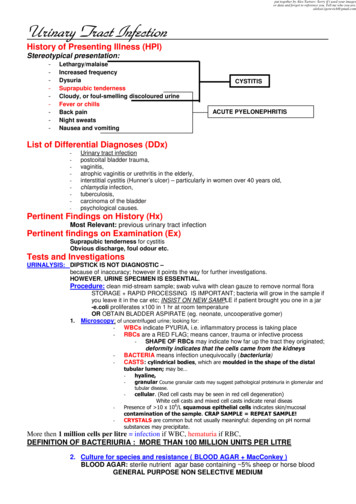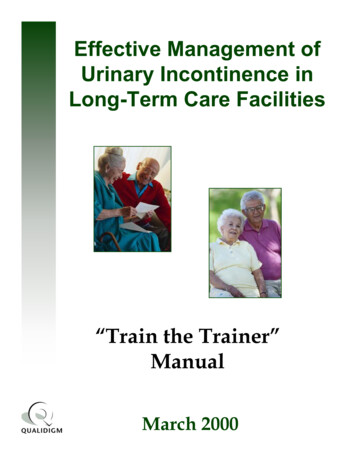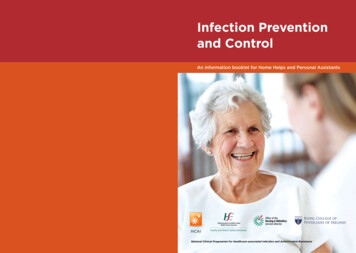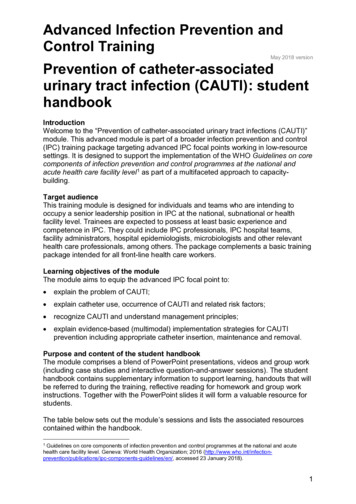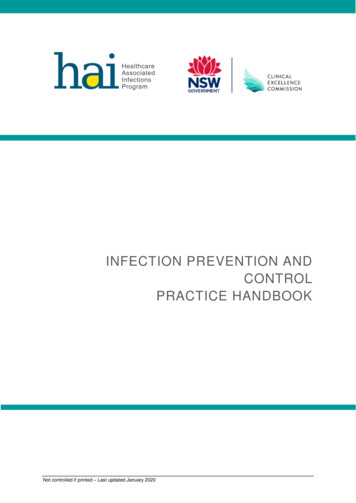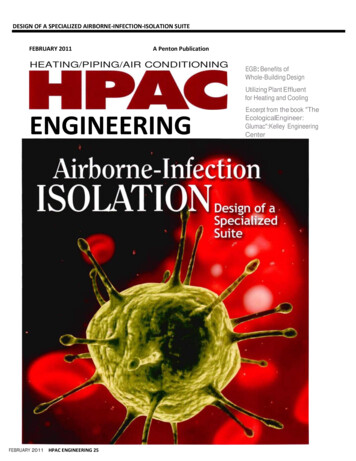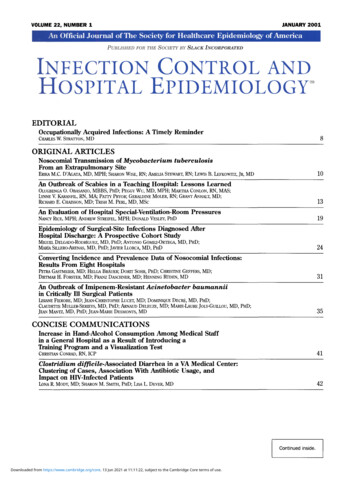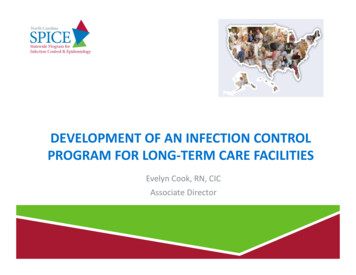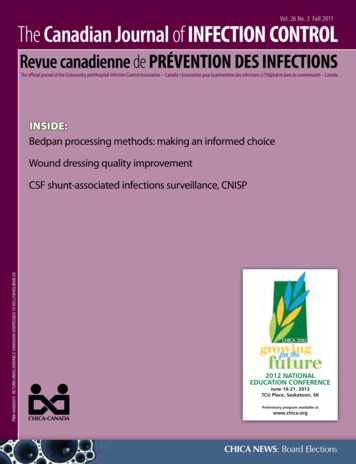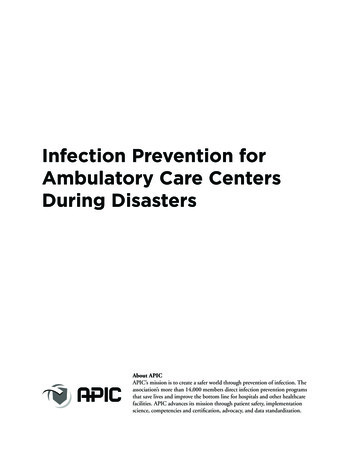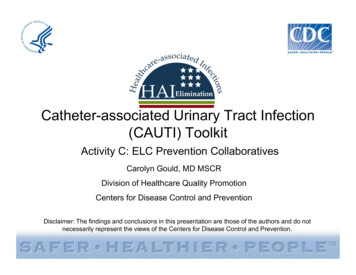
Transcription
Catheter-associated Urinary Tract Infection(CAUTI) ToolkitActivity C: ELC Prevention CollaborativesCarolyn Gould, MD MSCRDivision of Healthcare Quality PromotionCenters for Disease Control and PreventionDisclaimer: The findings and conclusions in this presentation are those of the authors and do notnecessarily represent the views of the Centers for Disease Control and Prevention.
Outline Background– Impact– HHS Prevention Targets– Pathogenesis– EpidemiologyPrevention Strategies– Core– SupplementalMeasurement– Process– OutcomeTools for Implementation/Resources/References
Background: Impact of CAUTI Most common type of healthcare-associatedinfection– 30% of HAIs reported to NHSN– Estimated 560,000 nosocomial UTIs annually Increased morbidity & mortality– Estimated 13,000 attributable deaths annually– Leading cause of secondary BSI with 10% mortalityExcess length of stay –2-4 days Increased cost – 0.4-0.5 billion per year nationally Unnecessary antimicrobial useHidron AI et al. ICHE 2008;29:996-1011Givens CD, Wenzel RP. J Urol 1980;124:646-8Klevens RM et al. Pub Health Rep 2007;122:160-6Green MS et al. J Infect Dis 1982;145:667-72Weinstein MP et al. Clin Infect Dis 1997;24:584-602Foxman B. Am J Med 2002;113:5S-13SCope M et al. Clin Infect Dis 2009;48:1182-8Saint S. Am J Infect Control 2000;28:68-75
Background: UrinaryCatheter Use 15-25% of hospitalized patients5-10% (75,000-150,000) NH residentsOften placed for inappropriate indicationsPhysicians frequently unawareIn a recent survey of U.S. hospitals:– 50% did not monitor which patients catheterized– 75% did not monitor duration and/or discontinuationWeinstein JW et al. ICHE 1999;20:543-8Munasinghe RL et al. ICHE 2001;22:647-9Warren JW et al. Arch Intern Med 1989;149:1535-7Saint S et al. Am J Med 2000;109:476-80Benoit SR et al. J Am Geriatr Soc 2008;56:2039-44Jain P et al. Arch Intern Med 1995;155:1425-9Rogers MA et al J Am Geriatr Soc 2008;56:854-61Saint S. et al. Clin Infect Dis 2008;46:243-50
Background:HHS Metrics and Prevention Targets # of symptomatic UTI / 1,000 urinary catheterdays as measured in NHSN– National 5-Year Prevention Target: 25% decreasefrom baseline Appendix G in HHS plan discusses a new typeof metric, the standardized infection ratio /appendices.html
Background: Pathogenesis ofCAUTI* Source ofmicroorganisms may beendogenous (meatal,rectal, or vaginalcolonization) orexogenous, usually viacontaminated hands ofhealthcare personnelduring catheter insertionor manipulation of thecollecting systemFigure from: Maki DG, Tambyah PA. Emerg Infect Dis 2001;7:1-6
Background: Pathogenesis ofCAUTI Formation of biofilms byurinary pathogenscommon on the surfacesof catheters andcollecting systems Bacteria within biofilmsresistant to antimicrobialsand host defenses Some novel strategies inCAUTI prevention havetargeted biofilmsScanning electron micrograph of S. aureus bacteriaon the luminal surface of an indwelling catheter withinterwoven complex matrix of extracellularpolymeric substances known as a biofilmPhotograph from CDC Public Health Image Library: http://phil.cdc.gov/phil/details.asp
CAUTI Definitions Surveillance definitions for UTI recently modified inNHSN (as of Jan 2009)– Please refer to NHSN Patient Safety Manualhttp://www.cdc.gov/nhsn/library.html Count symptomatic UTI (SUTI) only, not asymptomaticbacteriuria (ASB)– Exception is “ABUTI” (asymptomatic bacteremic UTI) – seeNHSN manual above Clinical significance of ASB unclear– Should not screen for or treat ASB routinely, except in certainclinical situations– Most literature to date includes ASB in outcomes, makinginterpretation of data difficult
Evidence-based Risk Factorsfor CAUTISymptomatic UTIProlonged catheterization*BacteriuriaDisconnection of drainage system*Female sex†Lower professional training of inserter*Older age†Placement of catheter outside of OR†Impaired immunity†Incontinence†DiabetesMeatal colonizationRenal dysfunctionOrthopaedic/neurology services* Main modifiable risk factors† Also inform recommendations
Prevention Strategies Core Strategies– High levels ofscientific evidence– Demonstratedfeasibility SupplementalStrategies– Some scientificevidence– Variable levels offeasibility*The Collaborative should at a minimum include core preventionstrategies. Supplemental prevention strategies also may be used.Most core and supplemental strategies are based on HICPACguidelines. Strategies that are not included in HICPAC guidelines willbe noted by an asterisk (*) after the strategy. HICPAC guidelines maybe found at www.cdc.gov/hicpac
Core Prevention Strategies(all Category IB) Insert catheters only for appropriate indications Leave catheters in place only as long as needed Ensure that only properly trained persons insertand maintain catheters Insert catheters using aseptic technique andsterile equipment (acute care setting) Following aseptic insertion, maintain a closeddrainage system Maintain unobstructed urine flow Hand hygiene and Standard (or appropriateisolation) Precautionshttp://www.cdc.gov/hicpac/cauti/001 cauti.html
Core Prevention StrategiesSpecific recommendations (IB) Insert catheters only for appropriate indicationshttp://www.cdc.gov/hicpac/cauti/001 cauti.html
Core Prevention StrategiesSpecific recommendations (IB) Insert catheters only for appropriate indications– Minimize use in all patients, particularly those athigher risk of CAUTI and mortality (women, elderly,impaired immunity)– Avoid use for management of incontinence– Use catheters in operative patients only as necessaryhttp://www.cdc.gov/hicpac/cauti/001 cauti.html
Core Prevention StrategiesSpecific recommendations (IB) Leave catheters in place only as long as needed– Remove catheters ASAP postoperatively, preferablywithin 24 hours, unless there are appropriateindications for continued usehttp://www.cdc.gov/hicpac/cauti/001 cauti.html
Core Prevention StrategiesSpecific recommendations (IB) Insert catheters using aseptic technique andsterile equipment (acute care setting)– Perform hand hygiene before and after insertion– Use sterile gloves, drape, sponges, antiseptic orsterile solution for periurethral cleaning, single-usepacket of lubricant jelly– Properly secure cathetershttp://www.cdc.gov/hicpac/cauti/001 cauti.html
Core Prevention StrategiesSpecific recommendations (IB) Following aseptic insertion, maintain a closeddrainage system– If breaks in aseptic technique, disconnection, orleakage occur, replace catheter and collecting systemusing aseptic technique and sterile equipment– Consider systems with preconnected, sealedcatheter-tubing junctions (II)– Obtain urine samples asepticallyhttp://www.cdc.gov/hicpac/cauti/001 cauti.html
Core Prevention StrategiesSpecific recommendations (IB) Maintain unobstructed urine flow– Keep catheter and collecting tube free from kinking– Keep collecting bag below level of bladder at all times(do not rest bag on floor)– Empty collecting bag regularly using a separate,clean container for each patient. Ensure drainagespigot does not contact nonsterile container.http://www.cdc.gov/hicpac/cauti/001 cauti.html
Core Prevention Strategies:Specific recommendations (IB) Implement quality improvement programsto enhance appropriate use of indwellingcatheters and reduce risk of CAUTIExamples:―Alerts or reminders―Stop orders―Protocols for nurse-directed removal ofunnecessary catheters―Guidelines/algorithms for appropriateperioperative catheter managementhttp://www.cdc.gov/hicpac/cauti/001 cauti.html
Supplemental PreventionStrategies: Examples Consideration of alternatives to indwellingurinary catheterization (II) Use of portable ultrasound devices for assessingurine volume to reduce unnecessarycatheterizations (II) Use of antimicrobial/antiseptic-impregnatedcatheters (IB, after first implementing corerecommendations for use, insertion, andmaintenance )http://www.cdc.gov/hicpac/cauti/001 cauti.html The following slides will provide further detailson supplemental strategies
Supplemental Prevention Strategies:Alternatives to Indwelling Catheterization Intermittent catheterization – consider for:– Patients requiring chronic urinary drainage forneurogenic bladder Spinal cord injury Children with myelomeningocele– Postoperative patients with urinary retention– May be used in combination with bladder ultrasoundscanners External (i.e., condom) catheters – consider for:– Cooperative male patients without obstruction orurinary retentionhttp://www.cdc.gov/hicpac/cauti/001 cauti.html
Supplemental Prevention Strategies:Bladder Ultrasound Scanners Rationale: fewer catheterizations lower risk of UTI 2 studies of adults with neurogenic bladderundergoing intermittent catheterization Inpatient rehabilitation centers Fewer catheterizations per day but no reporteddifferences in UTI– Significant study limitations: likely underpowered;UTIs undefinedPolliak T et al. Spinal Cord 2005;43:615-19Anton HA et al. Arch Phys Med Rehab 1998;79:172-5
Supplemental Prevention Strategies:Antimicrobial/Antiseptic-Impregnated UrinaryCatheters Considered using if CAUTI rates notdecreasing after implementing acomprehensive strategy– First implement core recommendations foruse, insertion, and maintenance– Ensure compliance with /001 cauti.html
Supplemental Prevention Strategies:Silver-Coated Catheters Decreased risk of bacteriuria compared to standardlatex catheters in a meta-analysis of RCTs Significant differences for silver alloy but not silveroxide-coated catheters Effect greater for patients catheterized 1 week Mixed results in observational studies inhospitalized patients– Most used laboratory-based outcomes (bacteriuria)– 1 positive, 2 negative, 5 inconclusivehttp://www.cdc.gov/hicpac/cauti/001 cauti.html
Supplemental Prevention Strategies:Silver-Coated Catheters One study in a burn referral center found adecrease in SUTI Pre-intervention catheters standard latex Intervention group had silver-impregnatedcatheters and had new catheters inserted onadmission under nonemergent sterile conditions– “The improved results in time period 2 are probablydue to the combination of these two changes intherapy.”Newton et al. Infect Control Hosp Epidemiol 2002;23:217-8
Summary of Prevention Measures* Core MeasuresSupplemental MeasuresInsert catheters only forappropriate indicationsLeave catheters in place onlyas long as neededOnly properly trained personsinsert and maintain cathetersInsert catheters using aseptictechnique and sterileequipmentMaintain a closed drainagesystemMaintain unobstructed urineflowHand hygiene and standard (orappropriate isolation)precautions Alternatives to indwellingurinary catheterizationPortable ultrasound devicesto reduce cimpregnated catheters*All recommendations in HICPAC guidelines at:http://www.cdc.gov/hicpac/cauti/001 cauti.html
Strategies NOT recommendedfor CAUTI prevention Complex urinary drainage systems (e.g., antisepticreleasing cartridges in drain port) Changing catheters or drainage bags at routine, fixedintervals (clinical indications include infection,obstruction, or compromise of closed system) Routine antimicrobial prophylaxis Cleaning of periurethral area with antiseptics whilecatheter is in place (use routine hygiene) Irrigation of bladder with antimicrobials Instillation of antiseptic or antimicrobial solutions intodrainage bags Routine screening for asymptomatic bacteriuria (ASB)http://www.cdc.gov/hicpac/cauti/001 cauti.html
Measurement: Examples ofProcess Measures Compliance with hand hygiene Compliance with educational program Compliance with documentation ofcatheter insertion and removal Compliance with documentation ofindications for catheter placementhttp://www.cdc.gov/hicpac/cauti/001 cauti.html
Measurement: RecommendedOutcome Measures Examples of metrics:– Number of CAUTI per 1000 catheter-days– Number of BSI secondary to CAUTI per 1000catheter-days– Catheter utilization ratio (urinary catheterdays/patient-days) x 100 Use CDC/NHSN definitions for numerator data(SUTI only): .gov/hicpac/cauti/001 cauti.html
Measurement: OutcomeUse NHSN Device-associated Modulehttp://www.cdc.gov/nhsn/library.html
Measurement Considerations May need to consider alternative metrics (inaddition to standard rates by device days) todemonstrate a reduction in CAUTIs if catheterdays (denominators) greatly reduced withinterventions Alternative denominator examples:– Patient days on unit– Numbers of catheters inserted
Evaluation Considerations Assess baseline policies and procedures Areas to consider– Surveillance– Prevention strategies– Measurement Coordinator should track newpolicies/practices implemented duringcollaboration
References/resources Gould CV, Umscheid CA, Agarwal RK, Kuntz G, Pegues DA, and HICPAC.Guideline for Prevention of Catheter‐associated Urinary Tract Infections2009.http://www.cdc.gov/hicpac/cauti/001 cauti.html IHI Program to Prevent CAUTI http://www.ihi.org/APIC CAUTI Elimination Guide http://www.apic.org/IDSA Guidelines (Clin Infect Dis 2010;50:625‐63)SHEA/IDSA Compendium (ICHE 2008;29:S41‐S50)National Quality Forum (NQF) Safe Practices for BetterHealthcare – Update April 2010 CDC/Medscape collaboration http://www.cdc.gov/hicpac/
Count symptomatic UTI (SUTI) only, not asymptomatic bacteriuria (ASB) – Exception is “ABUTI” (asymptomatic bacteremic UTI) – see NHSN manual above Clinical significance of ASB unclear – Should not screen for or treat ASB routinely, except in certain clinical situations – Most literature to date includes ASB in outcomes, making
